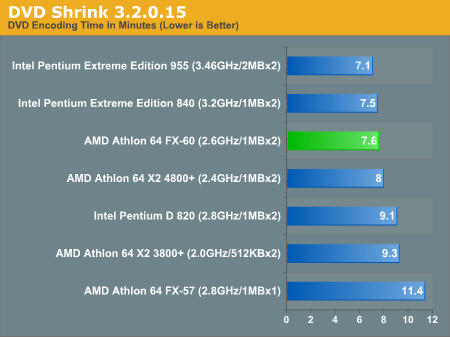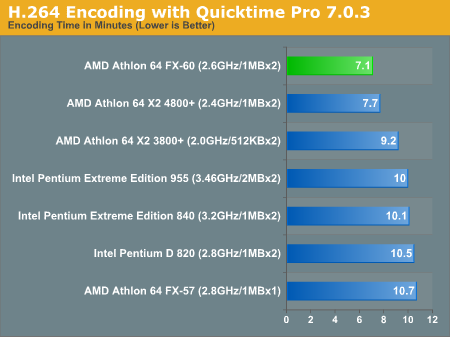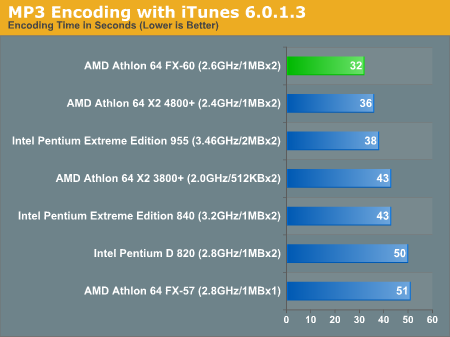AMD Athlon 64 FX-60: A Dual-Core farewell to Socket-939
by Anand Lal Shimpi on January 9, 2006 11:59 PM EST- Posted in
- CPUs
Media Encoding Performance using DVD Shrink, WME9, Quicktime and iTunes
First up is DVD Shrink 3.2.0.15. Our test was simple - we took a copy of Star Wars Episode VI and ripped the full DVD to the hard drive without compression, effectively giving us an exact copy of the disc on the hard drive. Then, using the copy of the DVD on the hard drive (to eliminate any DVD drive bottlenecks), we performed a DVD shrink operation to shrink the movie to fit on a single 4.5GB DVD disc. All of the options were left on their defaults, so the test ends up being pretty easy to run and reproduce. The scores reported are DVD encoding times in minutes, with lower numbers meaning better performance.
The DVD Shrink test is quite important as DVD Shrink is quite possibly one of the easiest tools to rip a DVD. The easier a tool is to use, the more likely it's going to be used, and arguably the more important performance using it happens to be.
Moving on, we have our Windows Media Encoder 9 test, which uses the advanced profile settings for video encoding. We left all settings at their defaults and just proceeded with a MPEG-2 to WMV-HD conversion. The values reported are in frames per second, with higher numbers being better.
Next up, we have Quicktime Pro 7.0.3 and we perform a MPEG-2 to H.264 encoding task. All of the settings are left at their defaults, with the exception that we optimize the output file for download with a 256kbps data rate while leaving the resolution untouched. We also adjust the video options to optimize for the best quality. We report the transcoding time in minutes, with lower values being better.
Finally, we have a MP3 encoding test using iTunes 6.0.1.3. For this test, we simply took a 304MB wav file and converted it to a 192kbps MP3 file, measuring the encode time in seconds. The only iTunes option that we changed was to prevent the playback of the song while encoding.
First up is DVD Shrink 3.2.0.15. Our test was simple - we took a copy of Star Wars Episode VI and ripped the full DVD to the hard drive without compression, effectively giving us an exact copy of the disc on the hard drive. Then, using the copy of the DVD on the hard drive (to eliminate any DVD drive bottlenecks), we performed a DVD shrink operation to shrink the movie to fit on a single 4.5GB DVD disc. All of the options were left on their defaults, so the test ends up being pretty easy to run and reproduce. The scores reported are DVD encoding times in minutes, with lower numbers meaning better performance.
The DVD Shrink test is quite important as DVD Shrink is quite possibly one of the easiest tools to rip a DVD. The easier a tool is to use, the more likely it's going to be used, and arguably the more important performance using it happens to be.

Moving on, we have our Windows Media Encoder 9 test, which uses the advanced profile settings for video encoding. We left all settings at their defaults and just proceeded with a MPEG-2 to WMV-HD conversion. The values reported are in frames per second, with higher numbers being better.

Next up, we have Quicktime Pro 7.0.3 and we perform a MPEG-2 to H.264 encoding task. All of the settings are left at their defaults, with the exception that we optimize the output file for download with a 256kbps data rate while leaving the resolution untouched. We also adjust the video options to optimize for the best quality. We report the transcoding time in minutes, with lower values being better.

Finally, we have a MP3 encoding test using iTunes 6.0.1.3. For this test, we simply took a 304MB wav file and converted it to a 192kbps MP3 file, measuring the encode time in seconds. The only iTunes option that we changed was to prevent the playback of the song while encoding.

3D Rendering Performance using 3dsmax 7
Gaming Performance using Battlefield 2, Call of Duty 2 and Quake 4










94 Comments
View All Comments
shortylickens - Tuesday, January 10, 2006 - link
Is it just me or does AMD seem to be moving architectures along a little too quickly?Socket A had an incredibly long lifespan. It moved from Athlon B's to C's (thunderbird) to XP to MP and even a Duron thrown in for good measure.
With the tow of the latest passing on (754,940) it seems like AMD just cant get it right. Now they are are already peaking with socket 939. From now on, we'll only have pity chips thrown to us just so we dont feel bad about going into it.
Well I feel bad. :(
Nyati13 - Tuesday, January 10, 2006 - link
Socket A was around for a long time, but there were 4 different FSB specs, several different chipsets, and 2 different RAM types all lumped under Socket A. You couldn't tell for certain that a Socket A CPU would work with any random Socket A motherboard because of all the spec changes. You can say that any Socket 939 CPU will work in any Socket 939 motherboard.DigitalDivine - Tuesday, January 10, 2006 - link
That's the disadvantage of having an integrated memory controller. Memory types change, and in the past there have been numerous memory types, in order to take advantage of the changes, amd has to change their socket.jakerugged - Tuesday, January 10, 2006 - link
In the review under the gaming tests you say - "We should also mention that we had to re-run our AMD numbers in this test since the last review as we were seeing sub-par AMD performance. A clean install and re-run of the numbers yielded the results you see today; the Intel numbers didn't change." Why did the Intel numbers NOT change and why did the AMD numbers change? Was it only in the Gaming tests or once you had good AMD numbers in the gaming tests did you then run the SYSMARK, etc tests in order to get max performance? If you did thats not good testing methodolgy. Can we see these sub-par numbers, how bad are they?Its ok to say that this CPU is fast but only if you add in that you may have to repeatedly re-load and re set-up your system until it is "just so" before it gives the kind of performance that you would expect.
Betwon - Tuesday, January 10, 2006 - link
About the of FX-60, they(both the websites) find:"our processor worked just fine at 2.8GHz clock speed. Unfortunately, Athlon 64 FX-60 didn’t get along with the 15x clock multiplier."--from xbitlabs
"With a retail AMD heatsink/fan, the best we could do is 2.8GHz at 1.40V. With more exotic cooling you could probably manage better, but stepping up the voltage all the way up to 1.50V wouldn't yield a 3GHz overclock on air."--from anand
They agree.
jakerugged - Wednesday, January 11, 2006 - link
Whoa there.....This has gone on a little bit longer than even I thought.My original comment was about the general stability of the FX60, because Anandtech.com just put in a little one liner about how they had to re-load the entire FX60 test rig (Im assuming this means re-install the O/S, all drivers, patches and benchmark tools.) because it was not performing correctly. They still have not said why or what these low figures were?
To be honest, Im not really into O/Cing but I am into stability and I dont want to have to re-load my system just so I can play a few games after using Word or sending a couple of e-mails.
Betwon - Tuesday, January 10, 2006 - link
About the of FX-60, they(both the websites) find:"our processor worked just fine at 2.8GHz clock speed. Unfortunately, Athlon 64 FX-60 didn’t get along with the 15x clock multiplier."--from xbitlabs
"With a retail AMD heatsink/fan, the best we could do is 2.8GHz at 1.40V. With more exotic cooling you could probably manage better, but stepping up the voltage all the way up to 1.50V wouldn't yield a 3GHz overclock on air."--from anand
They agree.
PrinceGaz - Tuesday, January 10, 2006 - link
Why don't you quote a bit more of what xbit labs said, Betwon?"We managed to get our CPU to work stably with the clock frequency multiplier set to 14x without increasing the Vcore, which equaled 1.3V throughout the entire test. In other words, our processor worked just fine at 2.8GHz clock speed. Unfortunately, Athlon 64 FX-60 didn’t get along with the 15x clock multiplier.
Having increased the Vcore by 10% above the nominal, we still couldn’t get our hero to run stably at 3GHz frequency. Although the CPU would boot the Windows XP just fine and could even go through some test applications, it would still crash to the Blue Screen of Death (BSOD) when both cores were fully loaded. So, we had to give up or desperate intention to conquer the 3GHz height.
We managed to get our processor to work absolutely impeccably at 2.9GHz with the Vcore set to 1.44V. This frequency was achieved as 14 x 207MHz."
So they managed 2.9GHz totally stable, not just 2.8GHz. And on the final page
"However, we shouldn’t say that Presler got completely and hopelessly defeated by the new Athlon 64 FX-60. Due to the new finer production technology, the new dual-core processors from Intel can boast excellent overclocking potential. As for the frequency potential of the AMD processors, it has been almost completely exhausted by now. As a result, when we compare the results demonstrated by the overclocked AMD Athlon 64 FX-60 and Intel Pentium Extreme Edition 955, the former is not always the winner. So, if you do not mind your system being a little bit noisy and generating quite a bit of heat, then Pentium Extreme Edition 955 might be a way to go."
Note the wording-- "the former [o/c FX-60] is not always the winner". The meaning being that the FX-60 at 2.9GHz beats the EE955 at 4.26GHz more often than not, but there are situations where the o/c EE955 wins. So when both are overclocked to their max, they are either equal or the FX-60 has a slight advantage overall. Of course the FX-60 has a significant advantage when it comes to heat, power consumption, and noise.
Betwon - Tuesday, January 10, 2006 - link
I had say that:"OC:
955 is 4.26GHz, FX-60 is 2.9GHz -->Now, the ratio is 1.46 (4.26/2.9). -->P4 starts to be better than X2. "
Note:
"As for the frequency potential of the AMD processors, it has been almost completely exhausted by now."
"Due to the new finer production technology, the new dual-core processors from Intel can boast excellent overclocking potential."
flyck - Tuesday, January 10, 2006 - link
but they also benchmark them both... and p4 is overclocked in those benchmarks still slower then X2. And they also say the power consumption of that overclocked p4 is insane.